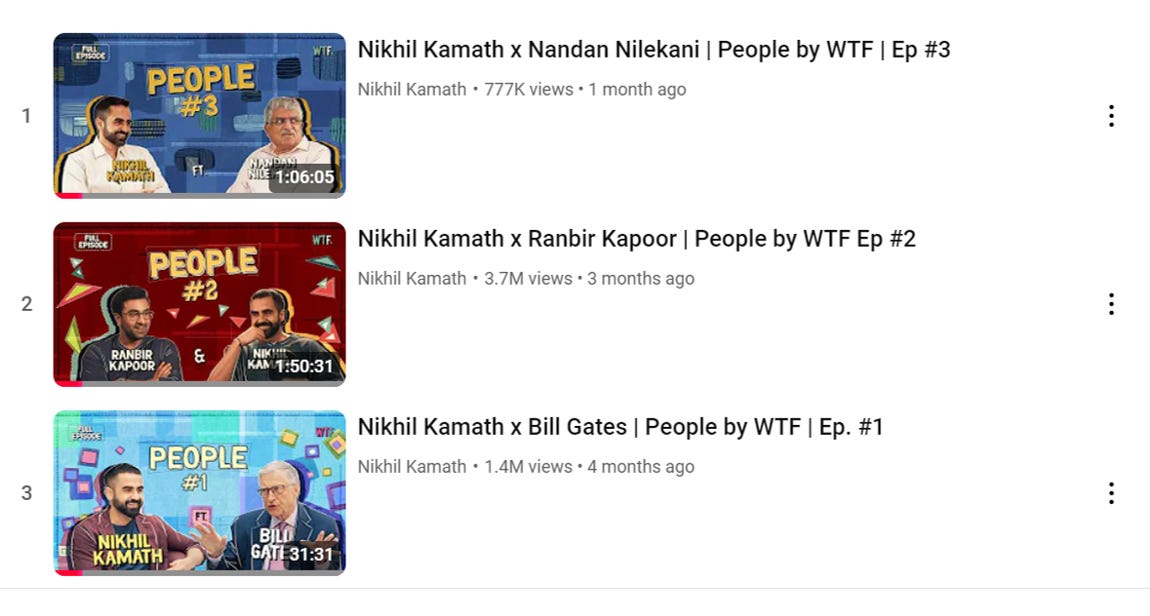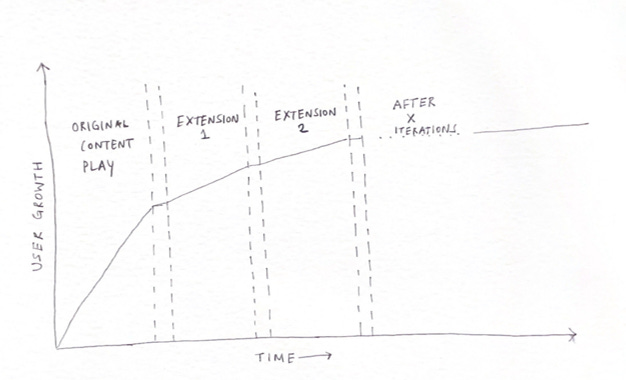The Rise and Rise of YouTube Podcasting in India
.. or how brands becoming creators could mean the death of a brand
On 27 July 2024, Nikhil Kamath (co-founder of Zerodha and host of ‘WTF is’ podcast) dropped an episode of his new series ‘People by WTF’ with Ranbir Kapoor. This was a significant departure from his previous guests—the one preceding it was Bill Gates, and the one succeeding it was Nandan Nilekani. It also departed from his usual roster of guests—entrepreneurs.
On 7th September 2024, Shantanu Deshpande (Founder and CEO of Bombay Shaving Company and host of ‘The Barbershop with Shantanu’ podcast) announced on LinkedIn, that he is adding to his content slate - ‘The Razor Sharp Project - an unafraid and curious exploration of social topics that affect us every single day’. Masculinity, Mental Health, Feminism, Fertility, Parenting etc.’
This too was a departure from his roster of guests (as Shantanu called it out) - Business/startups/commerce/money.
What was common to both approaches is what Shantanu lays out plainly in his post. And if I extend the same argument to Nikhil’s podcast, this is how I would sum it up (and grossly oversimplify it, because not everyone reads Arindam Paul’s newsletter for breakfast)
Running ads for revenue: Any new brand acquires users by running ads (or performance marketing if you please). For a brand with zero awareness, you need to show up, make people a compelling offer, and they buy. The cost of running ads is sustainable as the revenue generated from sales more than covers up for it (No, I will not say CAC and ROAS)
Plateau of despair: This works well until there comes a point that spending on ads does NOT help brands sustainably acquire (define sustainable basis whatever metric the brand is chasing) new users.
Running ads for brand building: They now need to invest in brand building, because it has been established empirically that brand building = long-term business success. This requires them to run ad campaigns (which are different from ads for making people buy). However, running these ads doesn’t always result in sales, so justifying this spending is hard. Plus, new brands are up against formidable, entrenched players with much more money to spend. Think 5x more money.
So you decide to do ‘Content’. Hardly a new idea, because blogs/white papers/thought leadership/SEO (Gross oversimplification alert!) have always been around. But so much of that is either need (search-based) or push (showing them the content through ads), which has limitations.
There is no ‘pull’ for such content.
Enter Video. Enter YouTube.
450 Mn+ monthly users in India. Nearly every conceivable demographic is on YouTube. You can reach people if you can make good, engaging content. Don’t make ‘In your face’ ads, but provide genuine value (entertainment/knowledge etc.) to a viewer. Leave it to the Algorithm Gods to take care of growth (Gross oversimplification alert!)
This is what Nikhil and Shantanu’s podcasts are about. Build content that appeals to their target group (Young (18-34) aspirational Indians living in the top 50 cities of India). Do it over time, and do it well and they shall come.
And they DID come.
So for Nikhil, the addition of Ranbir to the guest roster, and for Shantanu, the introduction of The Razor Sharp Project is the same Performance —> Brand situation playing out again.
Just in a different way.
Now play out this sequence of events infinitely (Ok, not literally, but a few times over). With the addition of new topics, the incremental audiences added will be small, and in far fewer iterations, it will be pointless to add more content extensions.
But why will the incremental audience be small?
Because both content and culture have evolved.
How culture evolved in the internet age
Democratisation → Fragmentation of content: The internet brought about the democratisation of content. Gatekeepers were suddenly irrelevant, tools of creation and distribution were in everybody’s hands. As content creators chased their own curiosities, they created content that revelled in their specific passions, and around them emerged a community of people, and audiences that built intimate connections with these creators. Even if they were niches, in a country like India, they consisted of millions of people.
From Mainstream to Subcultures: The democratisation of content led to the fragmentation of culture. As a child, the average millennial grew up with only 3 cultural reference points - Cricket, Bollywood and Religion, and you could have a conversation with anyone on at least one of these topics.
As millennials grew up in the digital era, we found our subcultures, as we stepped into our 30’s. We enjoyed our subcultures and took the online communities offline.
From Subcultures to Fandom: GenZ accelerated subcultures. What was a sense of community for millennials became a sense of identity for GenZ. Think Roblox and Swifties.
In the age of subcultures and fandoms, there is a limited appeal for any piece of content. Fragmentation is a feature, and not a bug, and is here to stay (If you work long enough in tech, you’d know that ‘bugs’ are also here to stay).
Now one could argue that they are not adding niches, but going after very large niches (The Mainstream is dead, long live The Mainstream), which usually subsume the original niche (in terms of reach).
E.g. Business/startups/commerce/money is a niche, that a limited number of people care about. However, masculinity / mental health/feminism etc. is a niche that a much larger number of people will care about. And most likely, the original niche is a subset of the bigger niche. So not only are you engaging your current audience, but you are also adding new audiences with this bigger niche.
Now let’s call each of these niches as an extension.
Now play out this sequence of events infinitely (Ok, not literally, but many times over). Each time an extended niche subsumes its predecessor, it will start moving towards NOT the mainstream, BUT irrelevancy.
In the bid to become something for everyone, it could end up becoming nothing for everyone.
In effect, it would no longer be a brand.
This is the central tension of a brand trying to become a creator. The need to keep expanding your content slate means that you now stand for everything, and thereby nothing.
You can no longer articulate the brand promise in a single line.
One could argue that these brands have sharply dissociated their names from the podcasts, only tangentially referring to them (Shantanu’s case) and not referring to them at all (Nikhil’s case). If that is true, all that the podcasts would do is build awareness for the brand (through founder association), which is hardly sufficient to drive consideration and loyalty for the brand.
I am not, in any way dissing the work these two companies (founders) have done to build these podcasts. As someone who has been podcasting for 5+ years, I have nothing but respect for them. Building a content engine like theirs is not for the faint-hearted.
All I am trying to ask is - How does this content-brand marriage play out in the future?
I don’t know. You tell me. Tell me what am I missing.
If you are new here, I am Utsav, who spends an unnecessary amount of his time thinking about content. As a creator, I have built a global top 2% podcast (Postcards from Nowhere), and I run The 6% Club - India’s first creator coaching program, designed for people with full-time jobs. We take you from idea to launch in 45 days.
P.S. If you came here to understand the rise of the creator podcast (and not the brand as a creator podcast), I got you! The post next week will be exactly that. Do subscribe to the newsletter, so it can hit your inbox directly.













Insightful analysis, Utsav. Thanks for sharing. Regarding the question at the end, here's what I think.
Maybe, the creators you mentioned are going for the expansion of their personal brand and not explicitly the business brand that they are currently known for. After all, once their basic needs are met, what most people desire is fame/power. And a growing personal brand with a dedicated audience does seem like winning this Game of Thrones in a way.